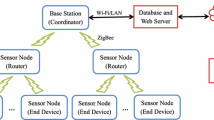Abstract
Indoor environments are characterized by several pollutant sources. Because people spend more than 90% of their time in indoor environments, several studies have pointed out the impact of indoor air quality on the etiopathogenesis of a wide number of non-specific symptoms which characterizes the “Sick Building Syndrome”, involving the skin, the upper and lower respiratory tract, the eyes and the nervous system, as well as many building related diseases. Thus, indoor air quality (IAQ) is recognized as an important factor to be controlled for the occupants’ health and comfort. The majority of the monitoring systems presently available is very expensive and only allow to collect random samples. This work describes the system (iAQ), a low-cost indoor air quality monitoring wireless sensor network system, developed using Arduino, XBee modules and micro sensors, for storage and availability of monitoring data on a web portal in real time. Five micro sensors of environmental parameters (air temperature, humidity, carbon monoxide, carbon dioxide and luminosity) were used. Other sensors can be added for monitoring specific pollutants. The results reveal that the system can provide an effective indoor air quality assessment to prevent exposure risk. In fact, the indoor air quality may be extremely different compared to what is expected for a quality living environment. Systems like this would have benefit as public health interventions to reduce the burden of symptoms and diseases related to “sick buildings”.













Similar content being viewed by others
References
Spengler, J. D., and Sexton, K., Indoor air pollution: A public health perspective. Science 221:9–17, 1983.
Jafari, M. J., Khajevandi, A. A., Mousavi Najarkola, S. A., et al., Association of sick building syndrome with indoor air parameters. Tanaffos 14(1):55–62, 2015.
EPA - United States Environmental Protection Agency (2015) Questions about your community: Indoor air. http://www.epa.gov/region1/communities/indoorair.html. Accessed 20 Oct 2015.
Mukhopadhyay, K., Ramasamy, R., Mukhopadhyay, B., Ghosh, S., Sambandam, S., and Balakrishnan, K., Use of ventilation-index in the development of exposure model for indoor air pollution—a review. Open J. Air Pollut. 2014. doi:10.4236/ojap.2014.32004.
Capristo, C., Romei, I., and Boner, A. L., Environmental prevention in atopic eczema dermatitis syndrome (AEDS) and asthma: Avoidance of indoor allergens. Allergy 59:53–60, 2004. doi:10.1111/j.1398-9995.2004.00652.x.
Joshi, S. M., The sick building syndrome. Indian J. Occup. Environ. Med. 12(2):61–64, 2008. doi:10.4103/0019-5278.43262.
Lee, J. H., Lee, H. S., Park, M. R., Lee, S. W., Kim, E. H., Cho, J. B., et al., Relationship between indoor air pollutant levels and residential environment in children with atopic dermatitis. Allergy, Asthma Immunol. Res. 6(6):517–524, 2014. doi:10.4168/aair.2014.6.6.517.
Ahn, K., The role of air pollutants in atopic dermatitis. J. Allergy Clin. Immunol. 34(5):993–999, 2014. doi:10.1016/j.jaci.2014.09.023.
Pitarma, R., Lourenço, M., Ramos, J., Improving ocupational health by modelling indoor pollutant distribution. Facilities 34(5/6), 2016.
De Vito, S., Fattoruso, G., Liguoro, R., Oliviero, A., Massera, E., Sansone, C., Casola, V., and Di Francia, G., Cooperative 3D air quality assessment with wireless chemical sensing networks. Procedia Eng. 25:84–87, 2011.
Preethichandra, D., Design of a smart indoor air qiuality monitoring wireless sensor network for assisted living. In: IEEE Instrumentation and measurement technology conference (I2MTC2013). pp. 1306–1310. NY: IEEE press, 2013.
Yu, T., Lin, C., An intelligent wireless sensing and control system to improve indoor air quality: Monitoring, prediction, and preaction. Int. J. Distrib. Sens. Netw. 2015.
Al-Haija, Q., Al-Qadeeb, H., and Al-Lwaimi, A., Case study: Monitoring of AIR quality in King Faisal University using a microcontroller and WSN. Procedia Comput. Sci. 21:517–521, 2013.
Yu, T., Lin, C., Chen, C., Lee, W., Tseng, C., Liu, S., and Lee, R., Wireless sensor networks for indoor air quality monitoring. Med. Eng. Phys. 35:231–235, 2013.
IEEE 802.15 WPAN Task Group4 (TG4). 2015. http://www.ieee802.org/15/pub/TG4.html. Accessed 15 Oct. 2015.
ZigBee Alliance. 2015. http://www.zigbee.org/. Accessed 15 Oct 2015.
Digi International Inc. 2015. http://www.digi.com/. Accessed 15 Oct 2015.
Ramya, V., Palaniappan, B., and George, B., Embedded system for automatic irrigation of cardamom field using Xbee-PRO technology. Int. J. Comput. Appl. 53(14):36–43, 2012. doi:10.5120/8491-2439.
Michael, M., Arduino cookbook. USA: O ReiLLY, 2012.
Arduino Website. 2015. http://www.arduino.cc. Accessed 23 Oct 2015.
Abraham, S., and Li, X., A cost-effective wireless sensor network system for indoor air quality monitoring applications. Procedia Comput. Sci. 34:165–171, 2014.
SHT10 Datasheet. 2015. https://www.adafruit.com/datasheets/Sensirion_Humidity_SHT1x_Datasheet_V5.pdf. Accessed 19 Oct 2015.
MQ7 Datasheet. 2015. https://www.sparkfun.com/datasheets/Sensors/Biometric/MQ-7.pdf. Accessed 19 Oct 2015.
Telaire T6615 Datasheet. 2015. http://www.ge-mcs.com/download/co2-flow/920-474C-LR.pdf. Accessed 19 Oct 2015.
LDR 5mm Datasheet. 2015. https://www.robocore.net/upload/attachments/sensor_ldr_gl5528_145.pdf.Accessed 19 Oct 2015.
Wang, M., Wang, Y., and Li, Q., Deployment of wireless sensor networks for air quality monitoring. Adv. Mater. Res. 712–715:1851–1855, 2013. doi:10.4028/www.scientific.net/AMR.712-715.1851.
Liao, Z., Peng, Y., Li, Y., Liang, X., Zhao, Y., A web-based visual analytics system for air quality monitoring data. In: 22nd International conference on geoinformatics (GeoInformatics). pp. 1–6. NY: IEE Press, 2014. doi:10.1109/GEOINFORMATICS.2014.6950834
Pitarma, R., Marques, G., and Caetano, F., Monitoring indoor air quality to improve occupational health. In: New advances in information systems and technologies. pp. 13–21. Springer International Publishing, 2016.
Author information
Authors and Affiliations
Corresponding author
Additional information
This article is part of the Topical Collection on Mobile & Wireless Health
Rights and permissions
About this article
Cite this article
Pitarma, R., Marques, G. & Ferreira, B.R. Monitoring Indoor Air Quality for Enhanced Occupational Health. J Med Syst 41, 23 (2017). https://doi.org/10.1007/s10916-016-0667-2
Received:
Accepted:
Published:
DOI: https://doi.org/10.1007/s10916-016-0667-2




